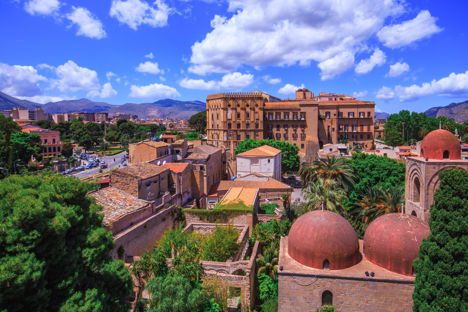
Culture clash: how North Africa changed Sicily forever
First the Carthaginians, then the Moors; Sicily was conquered twice over by invading North African forces. And while they didn’t give up their island without a fight, the resulting fusion of cultures gave birth to a truly unique way of life. Marisa Raniolo Wilkins highlights the most interesting culinary influences.
Culture clash: how North Africa changed Sicily forever
First the Carthaginians, then the Moors; Sicily was conquered twice over by invading North African forces. And while they didn’t give up their island without a fight, the resulting fusion of cultures gave birth to a truly unique way of life. Marisa Raniolo Wilkins highlights the most interesting culinary influences.
Whether you’re soaking up the rays in one of the many coastal villas in Trapani, tasting your way through the wines of Marsala or whiling away the days amongst the Roman ruins of Favignana, you might notice that, while you’re technically in Italy, the architecture is distinctively different. And when you walk around the markets, peer into pastry shop windows or peruse the menus of the local restaurants you’ll see saffron, pistachio, rosewater and cinnamon – certainly not the first things that come to mind when you think of Italian cuisine. That’s because Sicily is in a world of its own, with one of the most unique cultures in Europe. And it’s the island’s fascinating history that we have to thank for this.
To learn more, you only have to look at the dozens of different peoples that have colonised Sicily over the years. Before the Greeks and Romans, the Sicani, Elymi, Siculi and Phoenecians settled on the Mediterranean’s most appealing island. The long list of later arrivals includes Byzantines, Berbers, Moors, French and Spanish. These many colonisers didn’t just come armed with swords and spears; they also brought provisions and culinary traditions, and when the battles were done and they laid their weapons down, it was the unique, distinctive ingredients of their food that endured.
In the century and a half that the Arabs ruled Sicily, the island became a Mediterranean melting pot, blending Berbers (many of them converts to Islam) from North Africa, beside Jewish exiles from Andalusian Spain, plus the native Sicilians who were descendants of Greeks, Romans, Byzantines, Lombards and Latins who made their way south from Northern Italy.
Next came the Normans. The high point of the Norman’s Sicilian conquest occurred in the reign of King Roger II (1095-1154), who from his court in Palermo harmonised the cultural, religious and culinary traditions of Christian, Islamic and Jewish Sicilians. It was then that Arab and Norman activity became inextricably intertwined.
By this time, the exotic ingredients and flavours of North Africa permeated the cooking of western Sicily. The new ingredients they imported added sophistication and refinement to the island’s already intricate cuisine.
Farming
The Arabs saw great potential in the fertile lands of Sicily and brought with them a multitude of new fruit and vegetables along with sophisticated methods of irrigation that prolonged the growing season. They introduced different ways of preparing food, combining nuts, dried fruits, meats, vegetables, herbs and spices. This is why there are so many Sicilian dishes that are very different to the ones found in the rest of Italy. Many combine currants and pine nuts, lemon peel, cinnamon and sugar, and nowhere else in Italy is mint used so extensively in cooking.
They introduced spinach and probably aubergines (many Sicilian aubergine recipes are very similar to those prepared in most Middle Eastern countries). The Romans appreciated rice as an expensive product imported from India but the Arabs extended its cultivation – Sicilians use it to stuff vegetables or mould around fillings for arancini and tummala (timbale), a dish of finely minced meat or fish cooked with other ingredients and encased in rice, pasta or pastry. You’ll see these delicacies for sale all over the island – the perfect snack for when you’re exploring the countryside or enjoying back at your villa with a glass of cold, local wine.
Couscous
Couscous is a speciality of western Sicily. It is very likely that it was ferried back and forth between the island and its North African neighbours in what is now Tunisia, Libya, Algeria and Egypt. This trade and commerce continues to the present day. The Arabs would have used lamb and possibly chicken to make the broth to accompany the couscous but with the abundance of fish in Sicily this changed, and in Trapani it is served in a broth made with local fish. Despite sharing the common practice of forming the couscous into pellets, the Trapani version differs greatly from that made in Algeria, Tunisia and Morocco. It is a must-try dish when you’re staying in or near the city.
In North Africa couscous is usually steamed over the broth directly, but in Sicily it’s steamed over water and the fish broth is made separately before being poured over the couscous and left to be absorbed. Now that many of the immigrants who work on the fishing fleets and in vineyards in Sicily are living in these cities, it is not unusual to eat different variations of couscous, both sweet and savoury, made with fish, meat or harissa.
Saffron has a similar backstory. The Greeks and Romans knew of the spice but it was the Arabs who promoted its use more widely. It became an elegant spice in the Middle Ages, commonly used to colour and subtly flavour classic Sicilian dishes like arancini and pasta con la sarde.
Sweets
More than anything else, Sicily is famous for its sweets and pastries, and some of these delicacies are entirely based on the ingredients introduced from North Africa. One of the most important was sugar cane. The Arabs grew and processed it and with this came the evolution of the many distinctive baked and fried Sicilian pastries made with dried fruit, almond paste, nuts and seeds. Sesame seeds embedded in sugar-toffee, for example, are the basis for Sicily’s delicious torrone. In western Sicily, it is called cubbaita, while in the east it is known as giuggiulena. Both words are of Arabic origin. Other common dessert flavourings that owe their popularity to the Arabs are cinnamon and carob (an ingredient with certain health benefits that’s likened to chocolate).
Mulberries (gelsi) have the double benefit of being delicious – they are a popular flavouring for Sicilian gelati – and their leaves nurture silk worms, an important component of Arabic textile industries. Watermelon is another Arabic import; one mouthwatering treat that combines the best of Arabic flavours is gelo di melone, a jelly-like dessert made of watermelon juice and rosewater with a sprinkling of pistachio nuts. There’s no better way to cool off and quench your thirst with one of these after a day strolling around western Sicily’s beautiful countryside, except perhaps sorbetti, made from extracts of fruit, flowers or herbs or freshly squeezed lemon juice, sparkling seltzer water and a pinch of salt. Its name comes from the Italian for sherbet which is derived from the Arabic shahbah and selsa. Orange flower water, popular in the Middle East, is used to flavour some desserts and pastries. Jasmine water is also used in Sicily.
Somewhat similar to glacé fruit is a candied squash called zuccata. And the iconic zucca lunga – a pale green marrow as long as your arm – is also eaten as a pasta dish cooked with the tender leaves and tendrils of the plant (called tenerumi).
To top it all off there is cassata, a traditional Sicilian dessert that’s made by lining a bowl with layers of sponge cake soaked in liqueur, or in more ancient times following a non-alcoholic Islamic recipe, a sugar syrup with flower or orange water. It is likely that the name cassata comes from the Arabic word qas’ah; a deep, round terracotta bowl, that may have been used to shape the cake.
The chief ingredients are sheep’s milk ricotta mixed with sugar, cinnamon, small bits of dark chocolate, candied citrus and zuccata. The Arabs cannot take credit for the ricotta, sponge cake or chocolate but they may have contributed the other ingredients. The dessert is very sweet, highly decorated and usually covered with a striped green and white sugar fondant or made of marzipan. At one time the marzipan was also made with pistachios, hence the green. Cassata is usually decorated with some glacé fruit, especially citrus and ribbons of zuccata and citron (known in Italian as cedro) which is a fragrant citrus fruit, larger than a lemon with a thick rind that is candied and which, like orange and lemon peel, is used extensively in Sicilian pastries.
Sicily has been the bridge between the north, south, east and west. It is the fusion of various races, cultures and languages, touched by Africa, enriched by Islam and with its roots in Europe. The architecture is stunning and the views are unforgettable, but for the gourmands of the world, it is the unique melting pot of north African ingredients, Italian techniques and quintessential Sicilian flavours that makes visiting this island a culinary voyage of a lifetime.



